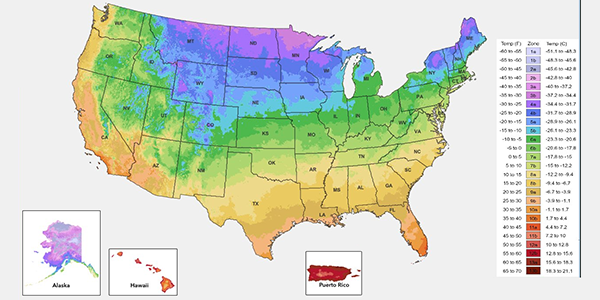||| FROM PHYS.ORG |||
The U.S. Department of Agriculture today released its new Plant Hardiness Zone Map, the national standard by which gardeners can determine which plants are most likely to survive the coldest winter temperatures at a certain location.
The USDA describes the latest map, jointly developed by Oregon State University’s PRISM Climate Group and the USDA’s Agricultural Research Service, as the most accurate and detailed it has ever released.
PRISM, part of the OSU College of Engineering, stands for Parameter-elevation Regressions on Independent Slopes Model. The previous version of the plant hardiness map, also based on PRISM data, was released in January 2012. The new plant hardiness map incorporates data from 13,412 weather stations, compared to the 7,983 that were used for the 2012 edition.
Viewable in a Geographic Information System-based interactive format, the map is based on 30-year averages (1991 to 2020) for the lowest annual winter temperatures within specified locations. The 2012 edition was based on averages from 1976 to 2005.
Low temperature during the winter is a crucial factor in the survival of plants at specific locations. The latest edition of PRISM’s signature product, the 30-year climate normals, was released in December 2021. PRISM releases new climate normals every 10 years, taking away one decade’s worth of data and adding another.
“The addition of many new stations and more sophisticated mapping techniques using the latest PRISM technology led to a more accurate and detailed Plant Hardiness Zone Map but also produced localized changes that are not climate-related,” said Christopher Daly, director of the PRISM Climate Group and the map’s lead author.
The plant hardiness map is divided into a total of 13 zones, each zone representing a 10-degrees-Fahrenheit range of temperatures. Each zone is further divided into two half zones, with each of those representing a 5-degree range.
“Overall, the 2023 map is about 2.5 degrees warmer than the 2012 map across the conterminous United States,” Daly said. “This translated into about half of the country shifting to a warmer 5-degree half zone, and half remaining in the same half zone. The central plains and Midwest generally warmed the most, with the southwestern U.S. warming very little.”
Accompanying the new map is a “Tips for Growers” feature that provides information about Agricultural Research Service programs likely to be of interest to gardeners and others who grow and breed plants.
The approximately 80 million American gardeners and growers are the most frequent map users, according to the USDA. In addition, the USDA Risk Management Agency uses the map in setting certain crop insurance standards, and scientists incorporate the plant hardiness zones into research models, such as those looking at the spread of exotic weeds and insects.
Provided by Oregon State University
**If you are reading theOrcasonian for free, thank your fellow islanders. If you would like to support theOrcasonian CLICK HERE to set your modestly-priced, voluntary subscription. Otherwise, no worries; we’re happy to share with you.**









I entered the zip code for Eastsound in the new Plant Hardiness Map and we are now in zone 9a. Last year’s map had us in zone 8a.